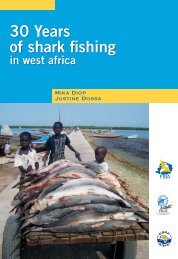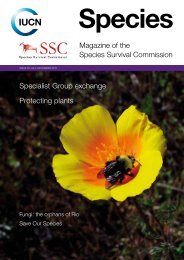Kyne & Simpfendorfer.. - Shark Specialist Group
Kyne & Simpfendorfer.. - Shark Specialist Group
Kyne & Simpfendorfer.. - Shark Specialist Group
You also want an ePaper? Increase the reach of your titles
YUMPU automatically turns print PDFs into web optimized ePapers that Google loves.
BIOGEOGRAPHY<br />
A broad-scale analysis of the biogeographical distribution of deepwater chondrichthyans<br />
reveals the highest levels of diversity in the Indo-West Pacific (Table 1.2). The Western and<br />
Eastern Atlantic have similar numbers of species, while diversity is lower in the Eastern<br />
Pacific. The Arctic and Antarctic regions are depauperate in terms of deepsea fauna. These<br />
biogeographical patterns follow general trends of chondrichthyan biogeography and diversity<br />
(Musick et al. 2004). The Indo-West Pacific is a large ocean region with a high level of<br />
endemism and thus it is not surprising that the highest diversity is recorded there. Lower<br />
diversity in the Eastern Pacific is attributable to a general lack of squaloid sharks, as<br />
previously recognised by Musick et al. (2004). Table 1.3 displays diversity by FAO Fisheries<br />
Areas (the United Nation's Food and Agriculture Organization's Major Fishing Areas for<br />
Statistical Purposes - maps of these can be located at<br />
ftp://ftp.fao.org/fi/maps/Default.htm#CURRENT), again illustrating high diversity in<br />
Fisheries Areas constituting the Indo-West Pacific, as well as in the Western Central Atlantic,<br />
a region centred around the tropical Caribbean Sea. (In Tables 1.2 and 1.3 the sum of totals<br />
exceeds the known number of deepwater species (581) as wider-ranging species occur in<br />
more than one region or Fisheries Area).<br />
Table 1.2. Deepwater chondrichthyan diversity by major ocean region*.<br />
Ocean region <strong>Shark</strong>s Batoids Holocephalans Total<br />
Arctic Sea 1 0 0 1<br />
Indo-West Pacific 190 123 28 341<br />
Eastern Pacific 49 41 8 98<br />
Western Atlantic 73 70 8 151<br />
Eastern Atlantic 72 58 12 142<br />
Antarctic seas 1 7 1 9<br />
*Arctic Sea (FAO Area 18); Indo-West Pacific (FAO Areas 51, 57, 61, 71, 81); Eastern Pacific (FAO<br />
Areas 67, 77, 87); Western Atlantic (FAO Areas 21, 31, 41); Eastern Atlantic (FAO Areas 27, 34, 37,<br />
47); Antarctic seas (FAO Areas 48, 58, 88).<br />
Table 1.3. Deepwater chondrichthyan diversity by FAO Fisheries Area.<br />
FAO Fisheries Area <strong>Shark</strong>s Batoids Holocephalans Total<br />
18 Arctic Sea 1 0 0 1<br />
21 Northwest Atlantic 18 13 3 34<br />
27 Northeast Atlantic 42 23 8 73<br />
31 Western Central Atlantic 59 37 5 101<br />
34 Eastern Central Atlantic 44 21 7 72<br />
37 Mediterranean and Black Sea 19 9 1 29<br />
41 Southwest Atlantic 26 27 3 56<br />
47 Southeast Atlantic 48 25 6 79<br />
48 Antarctic Atlantic 0 4 1 5<br />
51 Western Indian Ocean 68 27 5 100<br />
57 Eastern Indian Ocean 71 32 13 116<br />
58 Antarctic Indian Ocean 1 5 0 6<br />
61 Northwest Pacific 81 37 10 128<br />
67 Northeast Pacific 4 14 1 19<br />
71 Western Central Pacific 79 26 9 114<br />
77 Eastern Central Pacific 32 16 3 51<br />
81 Southwest Pacific 54 39 16 109<br />
87 Southeast Pacific 30 24 5 59<br />
88 Antarctic Pacific 0 2 0 2<br />
14
















